Table of Contents
Introduction
What are Sweaty Feet?
Sweaty feet, medically known as plantar hyperhidrosis, is a common condition characterized by excessive sweating of the feet. This condition can cause significant discomfort, embarrassment, and even lead to secondary problems like foot odor and infections. Understanding the underlying factors contributing to sweaty feet is crucial for effective management and treatment.
Understanding Hyperhidrosis
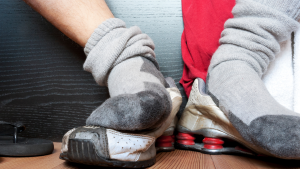 Hyperhidrosis is a medical condition that involves excessive sweating beyond what is necessary for regulating body temperature. This condition can affect various parts of the body, including the palms, face, underarms, and feet. When hyperhidrosis specifically affects the feet, it is referred to as plantar hyperhidrosis. Individuals with this condition often experience sweating that soaks through socks and shoes, even without engaging in physical activity or being in a warm environment.
Hyperhidrosis is a medical condition that involves excessive sweating beyond what is necessary for regulating body temperature. This condition can affect various parts of the body, including the palms, face, underarms, and feet. When hyperhidrosis specifically affects the feet, it is referred to as plantar hyperhidrosis. Individuals with this condition often experience sweating that soaks through socks and shoes, even without engaging in physical activity or being in a warm environment.
Prevalence and Impact
How Common is It?
Sweaty feet is a widespread issue that affects millions of people globally. Studies suggest that approximately 3% of the population suffers from some form of hyperhidrosis, with many cases going undiagnosed or untreated. While sweaty feet can occur at any age, it often starts in childhood or adolescence and can persist into adulthood.
Daily Life and Social Implications
The impact of sweaty feet extends beyond physical discomfort. Excessive foot sweating can lead to significant emotional and social challenges. Individuals with this condition may feel self-conscious about removing their shoes in public or participating in activities that require bare feet. The constant moisture can also cause skin problems, such as maceration, blisters, and fungal infections like athlete’s foot, further complicating the condition.
The Importance of Addressing Sweaty Feet
Health and Hygiene
Managing sweaty feet is crucial for maintaining good foot health and hygiene. Persistent moisture can create an ideal environment for bacteria and fungi to thrive, leading to unpleasant odors and infections. Addressing this condition can help prevent these complications and promote overall foot well-being.
Improving Quality of Life
Effective management and treatment of sweaty feet can significantly improve an individual’s quality of life. By reducing excessive sweating, individuals can enjoy greater comfort, increased confidence, and the freedom to engage in various activities without the worry of foot odor or dampness.
Causes of Sweaty Feet
Genetic Factors
Family History of Hyperhidrosis
One of the primary causes of sweaty feet is genetics. If you have a family history of hyperhidrosis, you are more likely to develop this condition. Research indicates that hyperhidrosis can run in families, suggesting a genetic predisposition to excessive sweating. Understanding your family’s medical history can provide insights into the likelihood of developing sweaty feet.
Medical Conditions
Hyperhidrosis
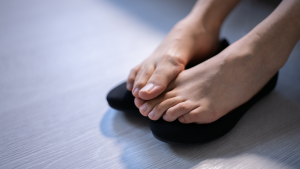 Hyperhidrosis is a medical condition characterized by excessive sweating. It can be primary, where the exact cause is unknown, or secondary, resulting from other underlying health issues. Primary hyperhidrosis typically starts in childhood or adolescence and can affect specific areas such as the feet, hands, underarms, or face. Secondary hyperhidrosis, on the other hand, is usually related to medical conditions like hyperthyroidism or diabetes.
Hyperhidrosis is a medical condition characterized by excessive sweating. It can be primary, where the exact cause is unknown, or secondary, resulting from other underlying health issues. Primary hyperhidrosis typically starts in childhood or adolescence and can affect specific areas such as the feet, hands, underarms, or face. Secondary hyperhidrosis, on the other hand, is usually related to medical conditions like hyperthyroidism or diabetes.
Hyperthyroidism
Hyperthyroidism, a condition where the thyroid gland produces excessive thyroid hormones, can lead to increased sweating, including in the feet. The overactive thyroid boosts metabolism, raising the body’s internal temperature and resulting in excessive sweating to cool down.
Diabetes
People with diabetes may experience excessive sweating due to nerve damage (neuropathy) affecting the sweat glands. This can cause both increased and decreased sweating, depending on which nerves are affected. Feet are particularly prone to these changes, leading to excessive moisture and potential complications.
Lifestyle Factors
Diet and Sweating
Certain foods and beverages can trigger excessive sweating. Spicy foods, caffeinated drinks, and alcohol can stimulate sweat glands, leading to increased sweating in susceptible individuals. Additionally, a diet high in processed foods can exacerbate sweating, whereas a balanced diet rich in fruits and vegetables may help regulate body temperature and reduce excessive sweating.
Exercise and Physical Activity
Physical activity naturally raises body temperature, prompting sweat glands to produce sweat to cool the body. Individuals who engage in regular, intense physical activity may notice increased foot sweating. While exercise-induced sweating is normal, excessive sweating beyond what is necessary for temperature regulation may indicate hyperhidrosis.
Environmental Factors
Weather Conditions
Hot and humid weather conditions can significantly increase the likelihood of sweaty feet. High temperatures cause the body to produce more sweat to cool down, and high humidity levels can make it difficult for sweat to evaporate, leading to persistently damp feet.
Footwear Choices
The type of footwear you choose plays a crucial role in managing foot sweat. Shoes made from non-breathable materials, such as synthetic fabrics and plastic, can trap heat and moisture, exacerbating foot sweating. Opting for shoes made from breathable materials, such as leather or mesh, can help reduce sweat accumulation.
Symptoms and Diagnosis
Common Symptoms
Persistent Foot Moisture
One of the most noticeable symptoms of sweaty feet is persistent moisture. Individuals with this condition often find that their feet remain damp, even when they are not engaging in physical activity or exposed to heat. This constant wetness can lead to discomfort and affect daily activities.
Foot Odor
Excessive sweating can create an environment where bacteria thrive, leading to unpleasant foot odor. The smell can be difficult to manage with regular hygiene practices alone and may require specific treatments to control bacterial growth and odor.
Skin Maceration
Prolonged exposure to moisture can cause the skin on the feet to become macerated, or softened. Maceration can lead to the skin appearing white and wrinkled, increasing the risk of skin breakdown and infections. This condition can be particularly problematic for individuals who wear shoes for extended periods.
Blisters and Fungal Infections
Sweaty feet are more susceptible to blisters and fungal infections, such as athlete’s foot. The constant moisture weakens the skin’s barrier, making it easier for friction to cause blisters and for fungi to invade. These conditions can cause significant discomfort and may require medical treatment to resolve.

Diagnostic Methods
Patient History and Physical Examination
Diagnosing sweaty feet typically begins with a detailed patient history and physical examination. The healthcare provider will ask about the onset and severity of symptoms, family history, and any associated medical conditions. A thorough examination of the feet will help assess the extent of sweating and identify any secondary issues like infections or skin changes.
Tests for Underlying Conditions
To rule out secondary hyperhidrosis caused by underlying medical conditions, various tests may be conducted. Blood tests can check for thyroid dysfunction or diabetes, while other tests may be used to evaluate overall health and identify potential triggers for excessive sweating.
Starch-Iodine Test
The starch-iodine test is a simple and effective method for diagnosing hyperhidrosis. During this test, an iodine solution is applied to the feet, followed by a layer of starch. If excessive sweating is present, the starch will turn dark blue or purple, indicating areas of high sweat production. This test helps in visually identifying and quantifying the extent of sweating.
Thermoregulatory Sweat Test
The thermoregulatory sweat test is a more comprehensive diagnostic tool used in specialized settings. This test involves applying a powder that changes color in response to moisture to the entire body. The patient is then exposed to a controlled warm environment to stimulate sweating. This test helps to assess the distribution and severity of sweating across the body, providing valuable information for diagnosing hyperhidrosis.
Potential Complications From Sweaty Feet
Skin Infections
Athlete’s Foot
Athlete’s foot is a common fungal infection that thrives in warm, moist environments, making sweaty feet particularly susceptible. This condition is characterized by itching, burning, and cracked skin, primarily between the toes. In severe cases, it can spread to other parts of the foot and even the body. Keeping feet dry and practicing good hygiene can help prevent athlete’s foot, but once contracted, it often requires antifungal treatments.
Fungal Infections
Beyond athlete’s foot, other fungal infections can also develop on excessively sweaty feet. Toenail fungus is a frequent issue, leading to thickened, discolored nails that can become painful over time. Fungal infections can be persistent and challenging to treat, often requiring both topical and oral antifungal medications. Maintaining dry, clean feet is crucial in preventing these infections.
Impact on Daily Life
Social and Emotional Implications
Sweaty feet can have significant social and emotional impacts. Individuals may feel embarrassed about removing their shoes in public or participating in activities that expose their feet. This self-consciousness can lead to avoidance behaviors, limiting social interactions and participation in sports or other activities. The constant worry about foot odor and visible sweating can also cause anxiety and stress, affecting overall mental well-being.
Challenges in Footwear and Activities
Excessive foot sweating can make choosing the right footwear challenging. Non-breathable shoes exacerbate the problem, while finding suitable moisture-wicking options can be time-consuming and expensive. Additionally, sweaty feet can make it difficult to maintain grip and stability in activities like running, hiking, or sports, increasing the risk of slips and injuries. Proper footwear and foot care are essential for mitigating these challenges and ensuring comfort and safety.
Treatments for Sweaty Feet
Over-the-Counter Solutions
Antiperspirants and Foot Powders
One of the first lines of defense against sweaty feet is the use of over-the-counter antiperspirants and foot powders. Antiperspirants containing aluminum chloride are effective in blocking sweat glands and reducing moisture. Foot powders, such as talcum powder or specialized antifungal powders, can help absorb excess sweat and keep feet dry. Regular application, especially before wearing shoes, can significantly reduce sweating and odor.
Best Absorbent Socks for Sweaty Feet
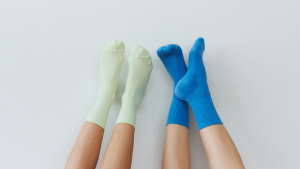 Investing in absorbent, moisture-wicking socks can make a substantial difference for those with sweaty feet. Materials such as cotton, wool, and synthetic blends designed to pull moisture away from the skin help keep feet dry throughout the day. Some of the best socks also come with antimicrobial properties to reduce the risk of infections and odor. Changing socks frequently, especially after physical activity, further enhances their effectiveness.
Investing in absorbent, moisture-wicking socks can make a substantial difference for those with sweaty feet. Materials such as cotton, wool, and synthetic blends designed to pull moisture away from the skin help keep feet dry throughout the day. Some of the best socks also come with antimicrobial properties to reduce the risk of infections and odor. Changing socks frequently, especially after physical activity, further enhances their effectiveness.
Prescription Treatments
Prescription Antiperspirants
For more severe cases of sweaty feet, prescription-strength antiperspirants may be necessary. These products typically contain higher concentrations of aluminum chloride compared to over-the-counter options, providing more robust sweat control. A healthcare provider can prescribe these antiperspirants, and they are applied similarly to their over-the-counter counterparts, usually at night to maximize effectiveness.
Topical Treatments
Topical treatments, such as gels or creams containing glycopyrrolate, can be prescribed to reduce sweating. These medications work by blocking the chemical signals that stimulate sweat glands. Applying these treatments directly to the feet can provide targeted relief and reduce overall moisture levels.
Oral Medications
In cases where topical treatments and antiperspirants are not sufficient, oral medications may be considered. Anticholinergic drugs, such as oxybutynin or glycopyrrolate, can help reduce sweating by inhibiting the activity of sweat glands. However, these medications can have side effects and are typically reserved for more severe cases under close medical supervision.
Medical Procedures
Iontophoresis
Iontophoresis is a non-invasive procedure that uses a mild electrical current to reduce sweating. During the treatment, the feet are submerged in water while a low electrical current is passed through, temporarily blocking sweat glands. Sessions typically last 20-30 minutes and may need to be repeated several times a week initially, followed by maintenance treatments. Iontophoresis is effective for many individuals and can be done at home with a prescribed device.
Botox Injections
These (botulinum toxin) injections effectively treat severe hyperhidrosis by temporarily blocking the nerves that stimulate sweat glands. Multiple injections are administered in the feet, significantly reducing sweating for several months. A dermatologist or specialist usually performs this treatment, and follow-up sessions may be necessary to maintain the results.
Surgery (Sympathectomy)
In extreme cases where other treatments have failed, surgery may be considered. A sympathectomy involves cutting or clamping the sympathetic nerves that control sweating in the feet. This procedure is typically reserved for severe hyperhidrosis that significantly impacts quality of life. While it can be highly effective, sympathectomy carries risks and potential side effects, so it is usually a last resort.
Home Remedies and Lifestyle Changes
Home Remedies
Vinegar Soaks
Vinegar is a natural astringent and antibacterial agent that can help reduce foot sweat and eliminate odor-causing bacteria. To use this remedy, mix one part vinegar with two parts water in a basin and soak your feet for 15-20 minutes. Apple cider vinegar or white vinegar can be used for this purpose. Regular vinegar soaks can help keep feet dry and reduce the risk of infections.
Tea Soaks
Tea contains tannic acid, which has astringent properties that can help reduce sweating. To make a tea soak, steep several tea bags in hot water, then allow the mixture to cool to a comfortable temperature. Soak your feet for 20-30 minutes. This can be done daily or several times a week to help manage sweat production and improve foot hygiene.
Baking Soda and Cornstarch
Baking soda and cornstarch are both excellent at absorbing moisture and neutralizing odors. You can sprinkle a mixture of equal parts baking soda and cornstarch into your shoes and socks to help keep your feet dry throughout the day. Additionally, applying this mixture directly to your feet can provide an extra layer of protection against sweat and odor.
Lifestyle Changes
Choosing Breathable Footwear
Selecting the right footwear is crucial for managing sweaty feet. Shoes made from breathable materials, such as leather or mesh, allow air circulation and help keep feet dry. Avoid shoes made from synthetic materials that trap heat and moisture. Additionally, rotating your shoes and allowing them to dry out between wears can prevent moisture buildup.
Maintaining Foot Hygiene
Good foot hygiene is essential for managing sweaty feet. Wash your feet daily with antibacterial soap and ensure they are thoroughly dried, especially between the toes. Regular exfoliation can help remove dead skin cells and reduce the risk of infections. Using antifungal powders or sprays can also help keep feet dry and odor-free.
Dietary Adjustments
Certain foods and beverages can trigger excessive sweating. Reducing your intake of spicy foods, caffeine, and alcohol may help control foot sweat. Incorporating a balanced diet rich in fruits, vegetables, and whole grains can support overall health and potentially reduce sweat production. Staying hydrated is also important, as dehydration can lead to increased body temperature and sweating.
 Sweaty Feet Prevention Tips
Sweaty Feet Prevention Tips
Daily Foot Care Routine
Regular Washing and Drying
Maintaining a daily foot care routine is crucial for preventing sweaty feet. Wash your feet thoroughly with antibacterial soap at least once a day, ensuring you clean between the toes. After washing, dry your feet completely, especially the spaces between the toes, as moisture can promote bacterial and fungal growth.
Using Antifungal Powders
Applying antifungal powders to your feet and inside your shoes can help absorb moisture and prevent fungal infections. These powders can be particularly effective during warmer months or when you expect to wear shoes for extended periods. They help keep your feet dry and reduce the risk of athlete’s foot and other infections.
Best Footwear and Socks for Sweaty Feet
Selecting Moisture-Wicking Materials
Choosing the right footwear and best socks can make a significant difference in managing sweaty feet. Opt for shoes made from breathable materials like leather or mesh that allow air circulation. Avoid synthetic materials that trap heat and moisture. For socks, select those made from moisture-wicking fabrics such as cotton, wool, or specialized synthetic blends designed to pull moisture away from the skin.
Rotating Shoes
Avoid wearing the same pair of shoes two days in a row. Rotating your shoes allows them to dry out completely between wears, reducing moisture buildup. Removing insoles and placing shoes in a well-ventilated area or using a shoe dryer can speed up the drying process and prevent odor and bacterial growth.
Managing Triggers
Identifying and Avoiding Dietary Triggers
Certain foods and beverages can trigger excessive sweating. Identifying and avoiding these triggers can help manage sweaty feet. Spicy foods, caffeine, and alcohol are common culprits. Keeping a food diary can help you identify which foods exacerbate your symptoms. Opting for a balanced diet rich in fruits, vegetables, and whole grains can support overall health and potentially reduce sweat production.
Stress Management Techniques
Stress and anxiety can increase sweating. Incorporating stress management techniques into your daily routine can help control excessive sweating. Practices such as yoga, meditation, deep breathing exercises, and regular physical activity can help reduce stress levels and improve overall well-being. Ensuring you get adequate sleep and maintaining a healthy work-life balance are also important for managing stress.
When to See a Doctor
Signs of Severe Hyperhidrosis
Excessive Sweating Impacting Quality of Life
While occasional foot sweating is normal, there are instances when the condition becomes severe and starts to interfere with daily life. If you find that your feet are constantly damp, even when you are not physically active or in a warm environment, it might be time to seek medical advice. Severe hyperhidrosis can lead to persistent discomfort, embarrassment, and practical issues such as difficulty keeping your feet dry in shoes, which can affect your daily activities and overall quality of life.
Persistent Infections
Frequent infections such as athlete’s foot, fungal nail infections, or bacterial skin infections are signs that your foot sweating may be more than just a minor inconvenience. These conditions can be difficult to manage and may require medical intervention. If you are experiencing recurring infections despite practicing good hygiene and using over-the-counter treatments, it is advisable to consult a healthcare professional.
Specialist Consultations
Dermatologists
Dermatologists specialize in skin conditions, including hyperhidrosis. They can provide comprehensive evaluations and recommend appropriate treatments tailored to your specific needs. Dermatologists can offer prescription-strength antiperspirants, topical treatments, and advanced therapies such as Botox injections or iontophoresis. Their expertise is valuable in managing severe cases of sweaty feet and related skin complications.
Podiatrists
Podiatrists are medical professionals who specialize in foot and ankle conditions. If excessive foot sweating is causing significant issues, a podiatrist can offer targeted solutions. They can recommend specialized foot care products, provide guidance on proper footwear, and perform procedures such as iontophoresis or laser treatments. Podiatrists can also address any structural foot problems that may be contributing to excessive sweating.
Frequently Asked Questions
How to Stop Sweaty Feet?
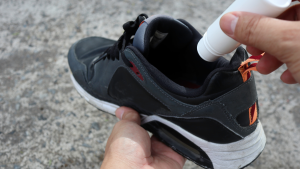 Stopping sweaty feet involves a combination of good hygiene practices, appropriate footwear, and effective treatments. Start by washing your feet daily with antibacterial soap and thoroughly drying them. Use moisture-wicking socks and breathable shoes to reduce moisture buildup. Over-the-counter antiperspirants and foot powders can help control sweat. For more severe cases, consider consulting a healthcare professional for prescription treatments or medical procedures.
Stopping sweaty feet involves a combination of good hygiene practices, appropriate footwear, and effective treatments. Start by washing your feet daily with antibacterial soap and thoroughly drying them. Use moisture-wicking socks and breathable shoes to reduce moisture buildup. Over-the-counter antiperspirants and foot powders can help control sweat. For more severe cases, consider consulting a healthcare professional for prescription treatments or medical procedures.
Why Are My Palms and Feet Sweaty All of a Sudden?
Sudden sweating of the palms and feet can be caused by various factors, including stress, anxiety, hormonal changes, or underlying medical conditions like hyperthyroidism or diabetes. If you notice a sudden onset of excessive sweating without an obvious cause, it is important to consult a healthcare provider to rule out any underlying health issues.
How to Cure Sweaty Feet?
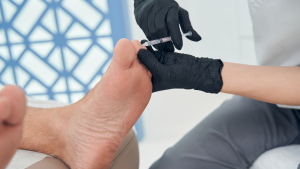 While there is no permanent cure for sweaty feet, various treatments can effectively manage and reduce symptoms. Over-the-counter solutions like antiperspirants and absorbent socks can help. Prescription treatments such as stronger antiperspirants, topical medications, and oral drugs may be necessary for more severe cases. Medical procedures like iontophoresis, Botox injections, or sympathectomy surgery are also options for those who do not respond to other treatments. Consulting with a dermatologist or podiatrist can help you determine the best approach for your situation.
While there is no permanent cure for sweaty feet, various treatments can effectively manage and reduce symptoms. Over-the-counter solutions like antiperspirants and absorbent socks can help. Prescription treatments such as stronger antiperspirants, topical medications, and oral drugs may be necessary for more severe cases. Medical procedures like iontophoresis, Botox injections, or sympathectomy surgery are also options for those who do not respond to other treatments. Consulting with a dermatologist or podiatrist can help you determine the best approach for your situation.
What Causes Sweaty Feet?
Sweaty feet can be caused by several factors, including genetics, medical conditions, lifestyle choices, and environmental influences. Genetic factors can predispose individuals to hyperhidrosis. Medical conditions like hyperthyroidism, diabetes, and hyperhidrosis can lead to excessive sweating. Lifestyle factors such as diet, exercise, and stress levels also play a role. Environmental factors, including hot and humid weather and non-breathable footwear, can exacerbate the condition.
Why Are My Feet Cold and Sweaty in Bed?
Cold and sweaty feet in bed can be due to several reasons, including poor circulation, hyperhidrosis, or the body’s response to certain medications or underlying medical conditions. When the body tries to regulate temperature, it can result in cold yet sweaty feet. Ensuring proper foot hygiene, using breathable bedding, and maintaining a comfortable room temperature can help alleviate these symptoms. If the problem persists, consulting a healthcare professional is advisable.
Can Diet Affect Foot Sweat?
Yes, diet can affect foot sweat. Certain foods and beverages, such as spicy foods, caffeine, and alcohol, can trigger excessive sweating. Maintaining a balanced diet rich in fruits, vegetables, and whole grains can help regulate body temperature and reduce sweat production. Staying hydrated is also important, as dehydration can increase body temperature and sweating.
How Can I Prevent Foot Odor Caused by Sweating?
Preventing foot odor involves maintaining good hygiene and using products that control moisture and bacteria. Wash your feet daily with antibacterial soap, dry them thoroughly, and apply antifungal powders or sprays. Use moisture-wicking socks and breathable shoes to keep your feet dry. Rotating your shoes and allowing them to dry out between wears can also help. Soaking your feet in vinegar or tea can reduce odor-causing bacteria.
Are There Specific Shoes That Help with Sweaty Feet?
Yes, certain shoes are better suited for individuals with sweaty feet. Look for shoes made from breathable materials like leather or mesh that allow air circulation. Avoid shoes made from synthetic materials that trap heat and moisture. Additionally, shoes with removable insoles can help absorb moisture and can be replaced or cleaned regularly.
Is Excessive Foot Sweating Hereditary?
Excessive foot sweating, or hyperhidrosis, can have a genetic component. If you have a family history of hyperhidrosis, you are more likely to develop this condition. Genetic predisposition plays a significant role, but environmental and lifestyle factors can also contribute to the severity of symptoms.
What Home Remedies Can Help with Sweaty Feet?
Several home remedies can help manage sweaty feet. Vinegar soaks and tea soaks can reduce sweating and eliminate odor-causing bacteria. Baking soda and cornstarch can be applied to absorb moisture and neutralize odors. Practicing good foot hygiene, wearing moisture-wicking socks, and choosing breathable footwear are essential steps in managing sweaty feet at home.
Can Sweaty Feet Lead to Athlete’s Foot?
Yes, sweaty feet can lead to athlete’s foot, a common fungal infection. The constant moisture creates an ideal environment for fungi to thrive. Maintaining dry feet, practicing good hygiene, and using antifungal powders or sprays can help prevent athlete’s foot. If you suspect you have athlete’s foot, over-the-counter antifungal treatments or prescription medications from a healthcare provider can effectively treat the infection.
Are Sweaty Feet a Sign of a Medical Condition?
Sweaty feet can be a sign of a medical condition, such as hyperhidrosis, hyperthyroidism, or diabetes. If you experience excessive sweating along with other symptoms like fatigue, weight changes, or increased thirst, it is important to consult a healthcare provider for a thorough evaluation. Identifying and addressing any underlying medical conditions is crucial for effective management.
What Are the Best Treatments for Sweaty Feet?
The best treatments for sweaty feet depend on the severity of the condition. Over-the-counter options include antiperspirants and foot powders. For more severe cases, prescription treatments such as stronger antiperspirants, topical medications, and oral drugs may be necessary. Medical procedures like iontophoresis, Botox injections, and sympathectomy surgery can provide relief for individuals who do not respond to other treatments. Consulting with a dermatologist or podiatrist can help determine the most appropriate treatment plan.
What Are the Best Socks for Sweaty Feet?
The best socks for sweaty feet are made from moisture-wicking materials that help keep your feet dry by pulling sweat away from the skin. Here are some features to look for in socks for sweaty feet:
- Moisture-Wicking Fabrics: Look for socks made from materials such as merino wool, bamboo, or synthetic fibers like polyester and nylon. These fabrics are designed to wick moisture away from the skin, keeping your feet dry.
- Breathability: Socks with mesh ventilation zones can help increase airflow around your feet, reducing sweat buildup.
- Antimicrobial Properties: Some socks are treated with antimicrobial agents to prevent the growth of odor-causing bacteria and fungi.
- Cushioning and Support: While keeping your feet dry, the best socks also provide cushioning and support to reduce friction and prevent blisters.
Conclusion
Summary of Key Points
Sweaty feet, also known as plantar hyperhidrosis, is a common condition that can cause significant discomfort and impact daily life. Understanding the causes, symptoms, complications, and treatment options is essential for effective management. Key points covered in this comprehensive guide include:
 Causes: Sweaty feet can be caused by genetic factors, medical conditions (such as hyperhidrosis, hyperthyroidism, and diabetes), lifestyle choices, and environmental influences.
Causes: Sweaty feet can be caused by genetic factors, medical conditions (such as hyperhidrosis, hyperthyroidism, and diabetes), lifestyle choices, and environmental influences.- Symptoms and Diagnosis: Common symptoms include persistent foot moisture, foot odor, skin maceration, blisters, and fungal infections. Diagnostic methods include patient history, physical examination, and specific tests like the starch-iodine test and thermoregulatory sweat test.
- Complications: Sweaty feet can lead to skin infections, social and emotional challenges, and difficulties with footwear and activities.
- Treatments: Options range from over-the-counter solutions (antiperspirants, foot powders, absorbent socks) to prescription treatments (stronger antiperspirants, topical treatments, oral medications) and medical procedures (iontophoresis, Botox injections, surgery).
- Home Remedies and Lifestyle Changes: Effective home remedies include vinegar and tea soaks, baking soda, and cornstarch. Lifestyle changes like choosing breathable footwear, maintaining foot hygiene, and making dietary adjustments can help manage symptoms.
- Prevention Tips: Daily foot care, selecting moisture-wicking materials, rotating shoes, and managing dietary and stress triggers are crucial for preventing sweaty feet.
- When to See a Doctor: Seeking medical advice is recommended for severe hyperhidrosis impacting quality of life or persistent infections. Dermatologists and podiatrists can provide specialized treatments and guidance.
Encouragement to Seek Help if Needed
If you struggle with sweaty feet and find that it affects your daily life, don’t hesitate to seek professional help. While home remedies and lifestyle changes can be effective, severe cases may require specialized treatments. Consulting with a dermatologist or podiatrist can provide you with personalized advice and access to advanced therapies that can significantly improve your condition.
Final Thoughts
Managing sweaty feet involves a multifaceted approach that includes understanding the condition, implementing practical solutions, and seeking medical advice when necessary. By taking proactive steps, you can reduce discomfort, prevent complications, and enhance your overall quality of life. Remember, you are not alone in dealing with this condition, and effective treatments are available to help you achieve dry, comfortable feet.

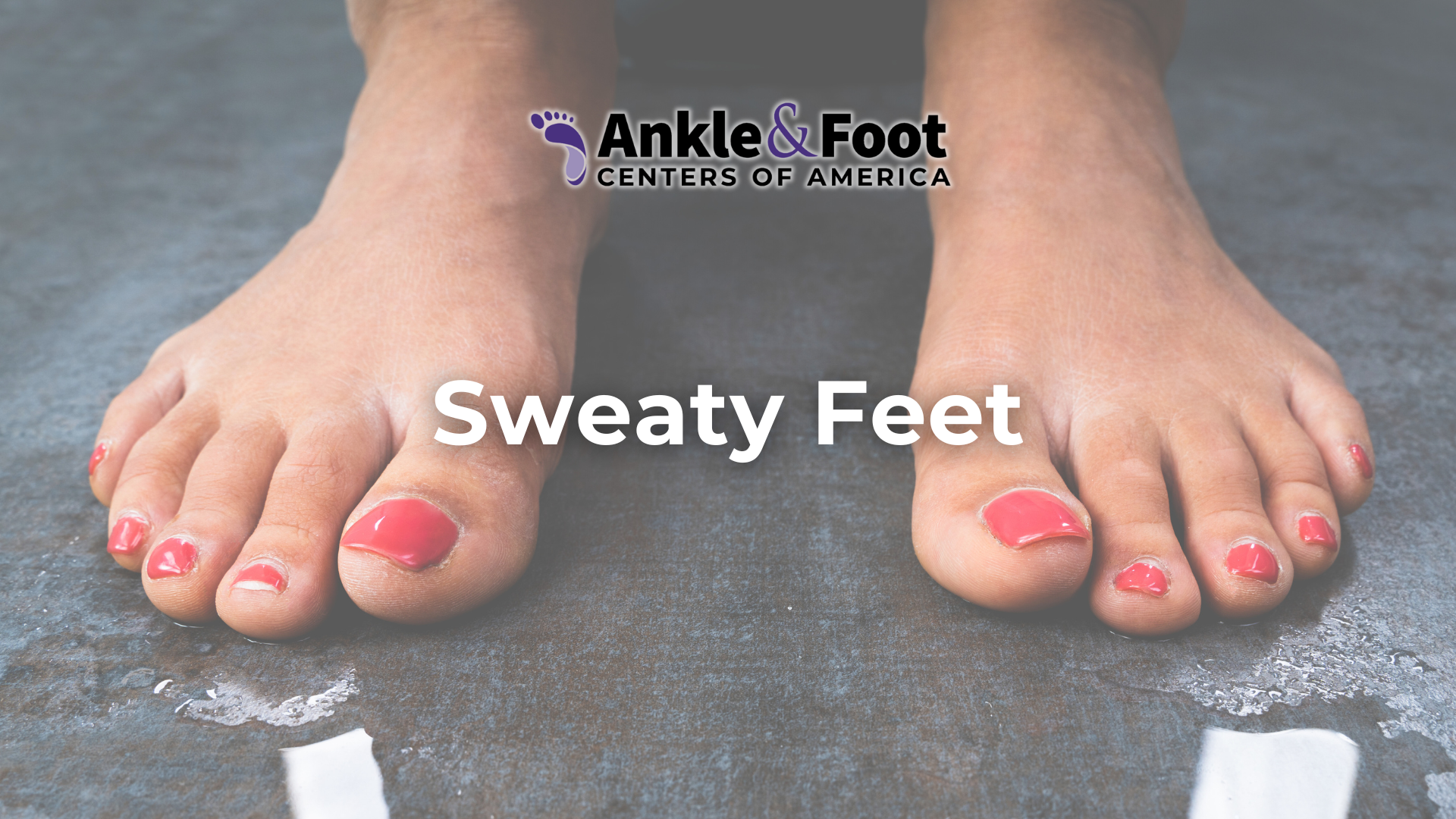
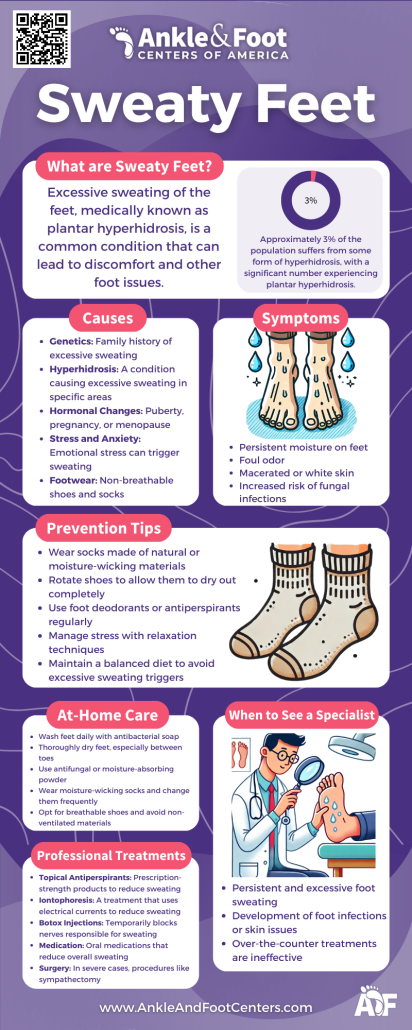 Sweaty Feet Prevention Tips
Sweaty Feet Prevention Tips Causes: Sweaty feet can be caused by genetic factors, medical conditions (such as hyperhidrosis, hyperthyroidism, and diabetes), lifestyle choices, and environmental influences.
Causes: Sweaty feet can be caused by genetic factors, medical conditions (such as hyperhidrosis, hyperthyroidism, and diabetes), lifestyle choices, and environmental influences.



